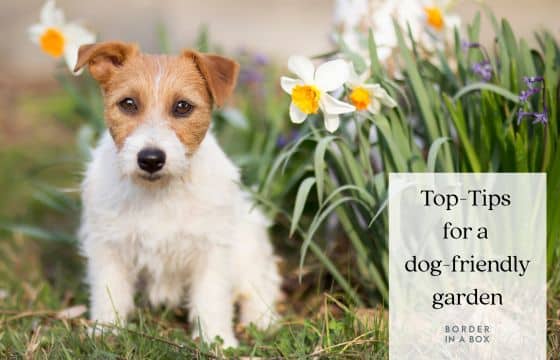Top-Tips for a Dog-friendly Garden

Dogs are the UK’s most popular individual pet, with around 12.5 million furry companions nationwide. Designing a garden that suits both dogs, and their owners can be a challenge, but with thoughtful planning, you can create a beautiful and safe outdoor space for everyone to enjoy.
Lush Lawns & Play Areas
Providing a dedicated space for play and exercise is essential—whether it’s fetching a ball or simply lounging in the sun. Grass or clover offers a soft surface that’s gentle on paws, but be mindful of dog urine, which contains high nitrogen levels and can lead to patchy, discoloured lawns.
Tip: Water affected areas promptly to dilute the nitrogen and prevent damage. You can also mix horticultural lime into the water to neutralize acidity and reduce lawn spots.
Thoughtful Garden Design
Dogs love exploration, so why not introduce winding pathways throughout the garden? Flank them with ornamental grasses like Miscanthus to create a natural flow.
Water features can be a fantastic addition, offering fun ways for dogs to cool off—just be sure to avoid chemical additives, as pets may try to drink from them. Also, watch for slugs, snails, and frogs, as they can carry lungworm, a risk to canine health. Regularly checking and removing them can help keep your pup safe.
Create shady areas such as trees and pergolas which will help to help keep them cool on hot sunny days.
Keep boundaries secure and ensure tunnelling isn’t possible to keep them safe.
Play Zones for Happy Pups
Encouraging safe digging can save your garden from unwanted damage. A sandpit or designated digging area will keep flower beds intact (with a little training!).
If space is limited, consider raised beds to protect plants from curious noses and paws. Fill them with dog-safe plants and mulch with bark chippings—but steer clear of cocoa bean shell, which smells appealing to dogs but is toxic if ingested.
Choosing Pet-Safe Plants
Some plants can be harmful to dogs, so it’s always wise to check before planting. Toxic species include foxglove, yew, aconite, hydrangea, and daffodils. For a comprehensive guide, The Dogs Trust offers a free online list of plants to avoid – you can download it for free here: Poisonous Plant List for Dogs
Instead, opt for non-toxic plants such as:
- Lavender – Fragrant and calming, ideal for sensory gardens.
- Viburnum – A robust shrub offering seasonal interest.
- Antirrhinum majus ‘Admiral White’ – A cottage garden favourite, blooming from June to September.
- Centaurea cyanus – A pollinator-friendly plant, flowering July to August, loved by butterflies and bees.
- Calendula officinalis – A vibrant bloomer from June to October, whose edible petals can even brighten up meals!
By combining safe plant choices, interactive features, and a secure environment, you can design a garden that’s not only stunning but also welcoming for your four-legged friend.
While the plants listed as “pet-safe” are generally considered non-toxic, individual dogs may still experience digestive upset, allergic reactions, or other health issues if they consume them. Additionally, some plants may be treated with pesticides, fertilizers, or other chemicals that could be harmful to pets. If a pet shows signs of poisoning—such as vomiting, lethargy, or unusual behaviour—seek veterinary care immediately.
 Free Delivery
Free Delivery Upgrade to 24 Hour Tracked Delivery
Upgrade to 24 Hour Tracked Delivery

